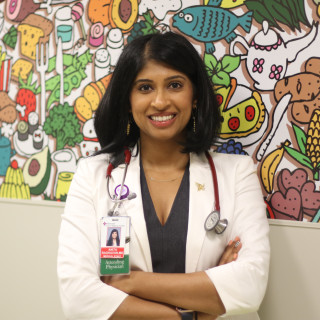 I’m drowning.
I’m drowning.
This is the story of the first time I failed. The story of the first time I gave 100% and it wasn’t enough. This is also the story of how I came to terms with that fact and why many of us advocate for “non-clinical” time and more full-time equivalent just to do our jobs safely.
The first time that I had too many patients to see and not enough time to care for them came shortly after I finished residency. In training, you were often overwhelmed but the buck never stopped with you. There was always a pop-off valve. In my first hospitalist job after residency, I was the sole inpatient provider. Period. I worked at a hospital 2.5 hours from where I lived. I would drive there and stay in a hotel for four days, drive home for four days, rinse and repeat. This hospital served a large rural/suburban population. It provided many tertiary care services and tried very hard not to transfer patients to other centers, given the burden of travel for caregivers (2+ hours). The hospital had a hard time hiring and retaining physicians and was chronically understaffed.
I joined the team as a pediatric hospitalist and my responsibility was to care for all pediatric inpatients. It was easy; I had done the same thing for the last three years in training and I was ready to be independent. I had medical students to teach but no residents. I was directly responsible for everything: orders, notes, phone calls, pages, etc. Though previously I had residents to teach and help with patient care, I took on the job with a gung-ho attitude: what a great learning experience for a new attending! In the fall, when the census was low, doing everything myself was easy. I had time to teach students, to round in all the rooms with the bedside nurse, to write my notes, to get patients discharged on time, etc. Then winter arrived and with it, the dreaded respiratory season.
I came into a weekend shift (7 a.m. – 7 p.m.) with a census of 22 patients. Translation: 22 sick children (each of whom I had to see and write orders for), 22 families to sit down one-on-one with. For about half of the patients, I would also need to do discharge (e.g., discharge medications, make follow-up appointments, explain to the families what they needed to do at home so they didn’t come back sick or get worse). Then, there was the documentation: a note for every patient I saw and a discharge summary for those going home (which also needed to be faxed to their primary care doctor). Oh, and those students? They were still around and wanted to be taught.
To make matters worse, whenever I discharged a patient, the emergency department admitted a new one, requiring a new admission history and physical (the longest note and encounter time), a new diagnosis (i.e., my job), and new orders, consultant calls, etc. It was a revolving door and I couldn’t find a way out. I was drowning.
If I just had to see those 22 patients and admit the 10 new ones, I think I could have gotten it done. But it was everything else. I just couldn’t keep up. I had pages and pages of to-dos with little empty boxes next to them. Those boxes judged me and my ineffectiveness. I hadn’t seen all the patients. I hadn’t eaten. I hadn’t even been to the bathroom! I had to see the sickest ones first, then the ones going home, then the new ones, then finally those in the middle. I kept apologizing. Sorry to the patients for being late. Sorry to the nurses for not returning pages or being able to deal with their needs. Sorry to the emergency room for not opening beds. Sorry to the students for not teaching them. Sorry to myself for taking this job. I was a firefighter putting out small fires here and there but the giant blaze was still roaring away.
I felt overwhelmed in a way that I never had before, even after being awake for 30 hours on call. In fact, 30 hours on call seemed easy. When I’d been on call, I’d had so many people there to help. This was different. I was alone.
I finally did finish all the work. My relief came at 7 p.m; by then, I had “tucked” in all the patients and I could run away from direct patient care. Then, I spent the next five hours sitting in front of a computer charting the last 12 hours of my life. All those progress notes, histories and physicals, discharge summaries, orders and faxes. I went home at midnight and fell into bed exhausted. I went in to work the next day and had a census of 18, easy compared to the day before.
Did I become a better doctor after shifts like this? Perhaps. I undoubtedly became more efficient and learned the art of delegating. Was it good medicine? Probably not. I know deep down that those patients in the middle (neither super sick, nor being discharged) didn’t get my 100% that day. Maybe I could have gotten them home sooner, weaned their fluids faster, reassured parents better. This story isn’t about how hard I worked, but about what is in patients’ best interests. Surveys of physicians’ workloads indicate that many providers find their limit at 15 patients. I was only at this institution for eight months and after, I worked at one of those fully-supported academic centers. When I had a busy shift there, I always thought back to that first time I failed. I took a deep breath, thankful that I had a team of residents, students, nurses, and other providers. I went back to my work.
I can’t say today that I never have days with 18+ patients, but I can say that since then, I’ve never once felt like drowning.
Dr. Anita Raghavan is an academic pediatric hospitalist at Akron Children's Hospital. She has experience as faculty for residency training programs and medical education. Dr. Raghavan also focuses on health care innovation, working with hospital-based enterprises. She completed medical school at Chicago Medical School and her pediatrics residency at Comer Children's Hospital at the University of Chicago. Dr. Raghavan just celebrated an exciting milestone, her son's first birthday! You can follow her @DrAnitaRaghavan on Facebook and @AnitaRaghavanMD on Instagram.







